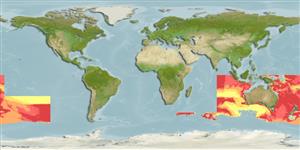Common names from other countries
Elasmobranchii (tubarões e raias) (sharks and rays) >
Carcharhiniformes (Ground sharks) >
Pentanchidae (Deepwater catsharks)
Etymology: Apristurus: a-, Latin privative, i.e., without; pristis, from pristes (Gr.), sawyer (but here meaning saw); oura (Gr.), tail, referring to absence of saw-toothed crest of enlarged dermal denticles along upper edge of caudal fin as found in the closely related Pristiurus (=Galeus). (See ETYFish); australis: Latin for southern, referring to its distribution in the southern hemisphere around Australia. (See ETYFish).
Environment: milieu / climate zone / depth range / distribution range
Ecologia
marinhas batipelágico; intervalo de profundidade 486 - 1035 m (Ref. 76943). Subtropical
Indian and Pacific coasts of Australia.
Comprimento de primeira maturação / Tamanho / Peso / Idade
Maturity: Lm 50.0, range 45 - 55 cm
Max length : 61.6 cm TL macho/indeterminado; (Ref. 76943)
This species has the following characters: flattened prenarial snout, apparently longer than interorbital width; furrows of upper labial much longer than the lower ones; pectoral fin widely expanding posteriorly, with outer margin a little longer than P1-P2 space; short abdomen, P1-P2 space narrower than preorbital length or anal fin base length; origin of first dorsal-fin just above or slightly anterior to pelvic-fin insertion; 50–64 and 48–68 tooth rows on upper and lower jaws, respectively; teeth with 5 or more cusps, including the anterior ones; egg capsule with no coiled tendrils on anterior and posterior ends, posterior end tapering toward tip; color preserved in alcohol is uniformly pale brownish to light greyish, sometimes light yellowish brown; the dorsal side of body is a little darker than ventral side (Ref. 76943).
Ciclo de vida ou comportamento de acasalamento
Maturities | Reprodução | Spawnings | Egg(s) | Fecundities | Larvas
Sato, K., K. Nakaya and M. Yorozu, 2008. Apristurus australis sp. nov., a new long-snout catshark (Chondrichthyes: Carcharhiniformes: Scyliorhinidae) from Australia. pp. 113-122. In Last, P.R., White, W.T. & Pogonoski, J.J. (eds.): Descriptions of New Australian Chondrichthyans. CSIRO Marine and Atmospheric Research Paper No. 22. (Ref. 76943)
Status na Lista Vermelha da UICN (Ref. 130435)
CITES (Ref. 128078)
Not Evaluated
Ameaça para os humanos
Harmless
Uso pelos humanos
Ferramentas
Relatórios especiais
Baixar XML
Fontes da internet
Estimates based on models
Preferred temperature (Ref.
115969): 2 - 8.7, mean 6.7 (based on 238 cells).
Índice de diversidade filogenética (Ref.
82804): PD
50 = 0.5000 [Uniqueness, from 0.5 = low to 2.0 = high].
Bayesian length-weight: a=0.00355 (0.00176 - 0.00714), b=3.09 (2.91 - 3.27), in cm Total Length, based on LWR estimates for this (Sub)family-body shape (Ref.
93245).
Nível Trófico (Ref.
69278): 3.9 ±0.4 se; based on size and trophs of closest relatives
Resiliência (Ref.
120179): Muito baixo(a), tempo mínimo de duplicação da população maior que 14 anos (Fec assumed to be < 10).
Fishing Vulnerability (Ref.
59153): Moderate vulnerability (45 of 100).
